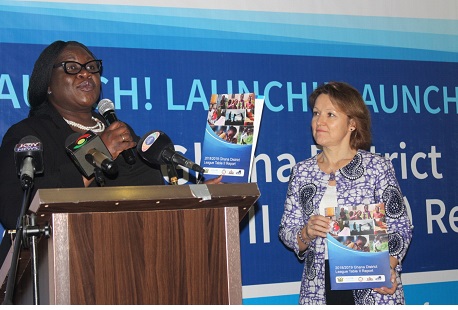Marian Kpakpa, Chief Director, Ministry of Planning (left) with Anne-Claire Dufay, UNICEF Representative with the documents
Results from the 2018/2019 District League Table (DLT) II have shown wide disparities within districts of the various regions in relation to social development and service delivery outcomes.
The DLT released in Accra today ranked Asante Akim North Municipal, in the Ashanti Region the overall best district, while Asokore Mampong Municipal, in the same Ashanti Region ranked the lowest performing district.
Again, the results ranked the Greater Accra Region as the best in the regional ranking, whereas Eastern Region was the worst, well below the positions of traditionally “poor” Regions like Upper East and Upper West.
Since the introduction of the first DLT in 2014, it has been used as a social accountability tool that ranks all of Ghana’s Districts by their level of social development and service delivery, providing evidence for enhanced decision-making.
Based on consultations with the key Ministries and Agencies concerned, the DLT II used indicators from seven key sectors including health, education, sanitation, water, child protection, governance and security, to compile a single score for each District.
Sector Analysis
Using the Basic Education Certificate Examination (BECE) results, Western Region topped the education sector with an impressive 88 percent while the Upper West recorded the poorest performance with 48 per cent.
Under the health sector indicator of skilled birth attendance, Upper East Region ranked the highest with 65 per cent while the Volta Region ranked the lowest with 45 per cent.
Central Region topped the chart with the highest number of birth registration recording 90 per cent coverage as compared to the Eastern Region which recorded just 58 per cent.
The Greater Accra Region topped the chart in water coverage under the sanitation sector with 77 per cent as Eastern Region had the lowest water coverage of 54 per cent.
Again under sanitation, the Upper West Region recorded 28 per cent of its communities certified as Open Defecation Free (ODF) while Ashanti and Western had none of its communities certified as ODF.
Anne-Claire Dufay, UNICEF Representative in Ghana, speaking at the launch said as Ghana seeks to achieve the sustainable Development Goals, (SDGs) it was useful to note the disparities between Districts and regions in social sectors to enable better prioritization, planning, resource allocation and implementation.
Dr. Yoshimi Nishino, Chief of Policy and Evidence Studies, UNICEF said a new way of calculating the total scores for the Districts and for the overall index was used to enhance the analysis of the data.
She cautioned the public to be careful in comparing this year’s results with previous years’.
Dr. Nishino added that the rural and urban water coverage rates were combined into one water indicator as well.
Each year, the results of the Ghana’s District League Table trigger constructive national debate and call for action towards improving social services for people in Ghana.
Prof. H Kwasi Prempeh, Executive Director of CDD-Ghana called for a national dialogue based on the results of the DLT.
The DLT is a result of a partnership between UNICEF, the Centre for Democratic Development (CDD-Ghana), the Centre for Social Policy Studies (University of Ghana – Legon), the Ministry of Local Government and Rural Development, as well as the Office of Head of Local Government Service.
By Jamila Akweley Okertchiri & Sarah Platz


